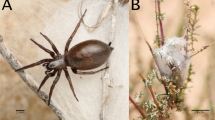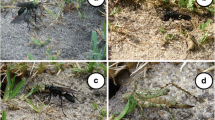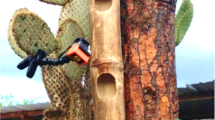Abstract
Two forms of intraspecific nest parasitism are described for the neotropical sand waspStictia heros (Fabr.). Females behaving aggressively made aerial attacks on prey-laden females as they approached their nest for provisioning. Attacks resulted in prolonged grappling on the sand, and the relative sizes of the contestants influenced final possession of the prey. Also, the probability that returning females were attacked was directly related to the size of the prey being delivered. Females displaying marauding behavior entered the nests of other females, removed prey, and deposited it in their own nest. Females usually raided nests that were near their own nest and tended to concentrate raiding attempts on nests that previously yielded prey. We also describe the behavior associated with the delivery of hunted prey and examine possible interrelationships between wasp size, prey size and hunting trip duration.
Similar content being viewed by others
References
Alcock, J. (1974). The behaviour ofPhilanthus crabroniformis (Hymenoptera: Sphecidae).J. Zool. 173: 233–246.
Alcock, J. (1982). Nest usurpation and sequential occupation in the digger waspCrabro monticola (Hymenoptera: Sphecidae).Can. J. Zool. 60: 921–925.
Alexander, B. (1986). Alternative methods of nest provisioning in the digger waspClypeadon laticinctus (Hymenoptera: Sphecidae).J. Kans. Entomol. Soc. 59: 59–63.
Bohart, R. M., and Menke, A. S. (1976).Sphecid Wasps of the World: A Generic Revision, University of California Press, Berkeley, CA.
Brockmann, H. J. (1980). Diversity in the nesting behavior of muddaubers (Trypoxylon politum Say; Sphecidae).Fla. Entomol. 63: 53–64.
Brockmann, H. J., and Dawkins, R. (1979). Joint nesting in a digger wasp as an evolutionarily stable preadaption to social life.Behaviour 71: 203–245.
Elliott, N. B., and Elliott, W. M. (1987). Nest usurpation by females ofCerceris cribosa (Hymenoptera: Sphecidae).J. Kans. Entomol. Soc. 60: 397–402.
Evans, H. E. (1966).The Comparative Ethology and Evolution of the Sand Wasps, Harvard University Press, Cambridge, MA.
Evans, H. E. (1970). Ecological-behavioral studies of the wasps of Jackson Hole, Wyoming.Bull. Mus. Comp. Zool. Harv. 140: 451–511.
Evans, H. E., and West-Eberhard, M. J. (1970).The Wasps, University of Michigan Press, Ann Arbor.
Evans, H. E., Kurczewski, F. E., and Alcock, J. (1980). Observations on the nesting behaviour of seven species ofCrabro (Hymenoptera: Sphecidae).J. Nat. Hist. 14: 865–882.
Field, J. (1989a). Intraspecific parasitism and nesting success in the solitary waspAmmophila sabulosa.Behaviour 110: 23–46.
Field, J. (1989b). Alternative nesting tactics in a solitary wasp.Behaviour 110: 219–243.
Field, J. (1992a). Intraspecific parasitism as an alternative reproductive tactic in nest-building wasps and bees.Biol. Rev. 67: 79–126.
Field, J. (1992b). Intraspecific parasitism and nest defence in the solitary pompilid waspAnoplius viaticus (Hymenoptera: Pompilidae).J. Zool. 228: 341–350.
Hager, B. J., and Kurczewski, F. E. (1985). Cleptoparasitism ofAmmophila harti (Fernald) (Hymenoptera: Sphecidae) bySenotainia vigilans Allen, with observations onPhrosinella aurifacies Downes (Diptera: Sarcophagidae).Psyche 92: 451–462.
Kurczewski, F. E., and Kurczewski, E. J. (1984). Mating and nesting behavior inTachytes intermedius (Viereck) (Hymenoptera: Sphecidae).Proc. Entomol. Soc. Wash. 86: 176–184.
Larsson, F. K. (1989). Temperature-induced alternative male mating tactics in a tropical digger wasp.J. Insect Behav. 2: 849–852.
Lin, N. (1963). Observations of suspected density dependent fighting between females of the cicada killer waspSphecius speciosus.Bull. Brooklyn Entomol. Soc. 58: 121–123.
Michener, C. D. (1974).The Social Behavior of the Bees, Harvard University Press, Cambridge, MA.
Newcomer, E. J. (1930). Notes on the habits of a digger wasp and its inquiline flies.Ann. Entomol. Soc. Am. 23: 552–563.
Rosenheim, J. (1988). Parasite presence acts as a proximate cue in the nest-site selection process of the solitary digger wasp,Ammophila dysmica (Hymenoptera: Sphecidae).J. Insect Behav. 4: 333–342.
Sheehan, W. (1984). Nesting biology of the sand waspStictia heros Hymenoptera: Sphecidae: Nyssoninae) in Costa Rica.J. Kans. Entomol. Soc. 57: 377–386.
Spofford, M. G., Kurczewski, F. E., and Peckham, D. J. (1986). Cleptoparasitism ofTachysphex terminatus (Hymenoptera: Sphecidae) by three species of Miltogrammini (Diptera: Sarcophagidae).Ann. Entomol. Soc. Am. 79: 350–358.
Steiner, A. L. (1975). Description of the territorial behaviour ofPodalonia valida (Hymenoptera: Sphecidae) females in southeast Arizona, with remarks on digger wasp territorial behaviour.Quaest Entomol. 11: 113–127.
Villalobos, E. M., and Shelly, T. E. (1994). Observations on the mating behavior of maleStictia heros (Hymenoptera: Sphecidae).Fla. Entomol. 77: 99–104.
Wcislo, W. T., West-Eberhard, M. J., and Eberhard, W. G. (1988). Natural history and behavior of a primitively social wasp,Auplopus semialatus, and its parasite,Irenangelus eberhardi (Hymenoptera: Pompilidae).J. Insect Behav. 1: 247–260.
Author information
Authors and Affiliations
Rights and permissions
About this article
Cite this article
Villalobos, E.M., Shelly, T.E. Intraspecific nest parasitism in the sand waspStictia heros (Fabr.) (Hymenoptera: Sphecidae). J Insect Behav 9, 105–119 (1996). https://doi.org/10.1007/BF02213726
Revised:
Issue Date:
DOI: https://doi.org/10.1007/BF02213726




